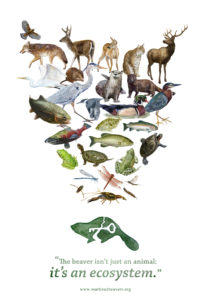I get a little excited every time I read a NRDC article about beavers. It just feels like the heavy weights have joined the fray. This was not a disappointment,
Partnering with Beavers to Adapt to Climate Change
 Mitigating climate change and adapting to a warming planet requires as many partners as we can muster. This includes embracing nature as a key ally. Estimates suggest that nature-based solutions can provide 37% of the mitigation needed to keep climate warming below two degrees Centigrade. And, nature, can help us prepare for the changes we are already experiencing and know are coming. Many people appreciate that if we plant more trees, they can both cool our cities and absorb carbon. But, perhaps less well known are the many benefits that beavers bring to the climate fight. Beavers are ecological engineers whose ponds store carbon, improve water quality, create habitat to support biodiversity, and help reduce climate impacts.
Mitigating climate change and adapting to a warming planet requires as many partners as we can muster. This includes embracing nature as a key ally. Estimates suggest that nature-based solutions can provide 37% of the mitigation needed to keep climate warming below two degrees Centigrade. And, nature, can help us prepare for the changes we are already experiencing and know are coming. Many people appreciate that if we plant more trees, they can both cool our cities and absorb carbon. But, perhaps less well known are the many benefits that beavers bring to the climate fight. Beavers are ecological engineers whose ponds store carbon, improve water quality, create habitat to support biodiversity, and help reduce climate impacts.
I’m dying of curiosity to know how they arrived at that figure. 37% of climate change relief? Really?
Riverscapes are stream or river habitats and their associated floodplains, wetlands, and riparian vegetation. These habitats are disproportionately important parts of the landscape, especially in arid and semi-arid regions. Riverscapes with beaver dam complexes are capable of naturally storing more water during storms and slowly releasing it later in the year. This reduces flood peaks and can prolong water availability during periods of heat and drought, supporting riparian vegetation and decreasing water-related stresses for aquatic and terrestrial wildlife. The wet, saturated soils and braided stream channels don’t readily burn and can therefore also serve as firebreaks, slowing the spread of fire, and giving firefighting teams time to contain them before they get out of control.
Now that is familiar and we know it well. Good for us. Good for beavers.
Beavers improve water quality and create biodiversity hotspots
Beaver-dam complexes improve water quality and reduce pollution. One way this is achieved is by providing a vegetated buffer between agricultural lands, transportation corridors, and other land uses and adjacent water bodies, which can filter out pollution and sediment before they can impact water quality. Maintaining or increasing beavers and their habitat benefits a wide array of native aquatic and terrestrial species. Beaver habitat provides microclimates and shade, complex hydraulics, clean and abundant water, nutrient cycling, and food-web support for a wide range of aquatic and terrestrial organisms, including endangered species. These benefits increase in importance as the climate warms.
 You mean like this? Yes beavers really make biodiversity hotspots. Do you know I’ve seen three different organizations in three states copy this design and advertise it as their own. I guess that’s a kind of flattery.
You mean like this? Yes beavers really make biodiversity hotspots. Do you know I’ve seen three different organizations in three states copy this design and advertise it as their own. I guess that’s a kind of flattery.
Today, the beaver population in North America is estimated to be 10-15 million animals. And, wetlands in the continental United States have been reduced by more than half. Where beavers are absent or reduced in number, we are left without the rodent partners that can repair and restore our degraded streams and wetlands and sustain the ecosystem services communities need. Luckily, we can help nature bring back the conditions that beavers need by kickstarting natural processes. If we take steps to make riverscapes healthier again, beavers can return and get to work making dams of their own. Once this happens, ecosystem services can start to accrue.
I know right away the number one thing I would do to let beavers help with climate change. Get out of their way and stop killing them. That would be a great start.
The White House recently released a report outlining how we can invest in nature to solve today’s challenges. The report called out protecting beavers as a nature-based solution and recommends using federal facilities and assets to deploy a suite of nature-based approaches. To accomplish this, the Department of Interior and U.S. Department of Agriculture should work together to launch a National Healthy Riverscape Initiative to prioritize and invest in maintaining and restoring freshwater habitat on public lands. To support such an effort, the Bureau of Land Management should finalize its Public Lands Rule with strong provisions for both conserving and restoring priority lands and waterways. At the same time, the Federal Emergency Management Agency (FEMA) should increase investments in wetland protection and restoration to support communities and tribes seeking to invest in nature-based solutions to reduce future flooding or increase ecological resilience to drought. By protecting and recovering the places that beavers live, programs such as these can give these critical animals an opportunity to revitalize the entire landscape.
And get out of their way and stop killing them. Don’t forget that part.
In 2022, the California legislature provided essential funding to the California Department of Fish and Wildlife to invest in beavers’ natural ability to improve ecosystem health and help adapt to climate change. The agency is currently staffing up and developing a comprehensive beaver management program. Across the country, states are working to update their State Wildlife Action Plans (SWAPs) which will guide fish and wildlife conservation starting in 2025. Congress requires a SWAP for all states and territories that apply to the State and Tribal Wildlife Grants program which has distributed over one billion dollars since 2000. While beavers aren’t threatened, their beaver ponds create essential habitat for many species of greatest conservation need. Protecting and restoring beaver habitat should be prioritized in SWAPs. Finally, state, tribal, and local governments, can prioritize wetland protection and restoration to help reconnect streams to their floodplains as a risk mitigation strategy in the hazard mitigation plans required to secure grants from FEMA.
Okay. You can use California as a model. I’m not sure what they’ve accomplished yet but sure, it’s a start.
Tribes across the West are demonstrating what is possible when beavers are returned to the landscape. The Tulalip Beaver Project relocates “nuisance” beavers to hydrologically impaired tributaries in Washington’s upper Snohomish Watershed to improve fish rearing habitat and retain more freshwater in the watershed for longer periods of time. In Montana, the Blackfeet Nation’s Ksik Stakii Beaver Mimicry Guidebook focuses on mimicking beaver habitat to restore streams and naturally store water. And, in California, Indigenous leaders are leading the way in advocating for policies that support beavers to benefit salmon conservation and contribute to holistic land restoration.
Yeah. Okay. Hype California again.
If given the chance, beavers can serve as a free restoration workforce that increases our ability to adapt to climate change while also stemming biodiversity loss. Positive stories of communities, tribes, and landowners partnering with beavers are emerging across the country—let’s create more of them.
That last line is my favorite in the entire article. POSITIVE STORIES OF COMMUNITIES. Let’s create them. Tell them. Share them. And spread them. I think Martinez agrees with that.
By the way did you see that recently this was voted the most popular mural in Claycord?








































2 comments on “BEAVERS, CLIMATE CHANGE AND THE POWER OF POSITIVE STORIES”
MARSHA HEATWOLE
August 25, 2023 at 8:24 amas archivist of all things beaver. my friend gave me an article in the august ’23 copy of “the Week’ magazine. i cannot access the article on line but you may want to try harder ( pay the 2 $ or so of the e version or get permission for the article. in the part of the magazine called the last word title of article called ‘ rewilding’ nature , mostly about a quy- Olivier Rubbers who moved a bunch (flock,herd?) of beavers illegally from germany to belgium. interesting quotes. beaver bombing and it is illegal but is it wrong?
MARSHA HEATWOLE
August 25, 2023 at 8:26 amoh and thnks for pputting grey owls speech up front on your page here. always makes me cry. when you take away the beavers you break the chain. am reading the future earth for science friday book club. they read beaverland this spring.